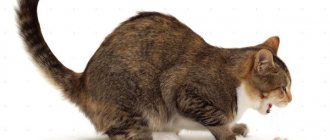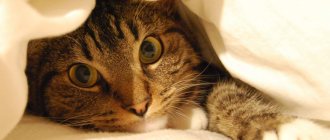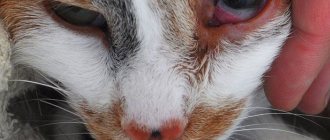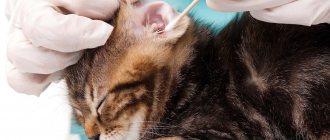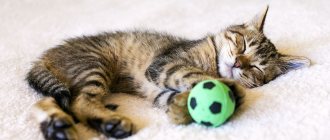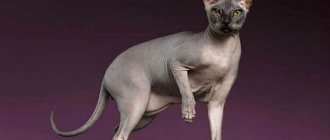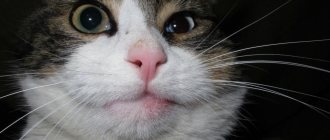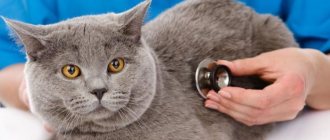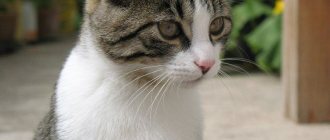What is the norm of saliva secretion?
There are times when it is normal for a cat to drool. Saliva is an important fluid in the body that performs a number of functions: protects teeth, gums and oral mucosa from damage, facilitates chewing food by lubricating or gluing it, facilitates swallowing, has a bactericidal effect, and much more. That is why, in some cases, copious amounts of saliva should not cause you concern, namely :
- when an animal sees food or smells it;
- during feeding;
- while chewing food;
- when she is stroked and your pet enjoys it;
- Current drooling in a cat can be observed when taking tasteless and bitter medications (for example, no-shpa or deworming medications);
- with strong nervous feelings.
The amount of saliva produced usually only increases slightly if the cat's health is good. Usually, saliva can be seen a little on the fur around the mouth, but if the process lasts longer than 10-15 minutes and there is much more drool, you should start to worry.
The process of salivation or drooling itself is called salivation , so if you notice any abnormalities regarding this phenomenon and decide to see a doctor, do not be alarmed if he diagnoses hypersalivation or ptyalism. These scary words just mean that the cat is drooling more than it should from its mouth.
Preventive measures
What can you do to prevent your cat from sticking out his tongue and drooling? It is necessary to eliminate, as far as possible, factors that can provoke a large amount of salivation. Choose toys that are soft and have rounded edges. Examine your pet's mouth every day . It is also necessary to pay attention to whether your pet has bad breath. Do not give sharp bones that can injure teeth, gums or tongue.
It is necessary to periodically take the animal to an appointment with a veterinarian, who will conduct an examination and do all the necessary tests. He will also make a diagnosis and prescribe the correct treatment, which will lead to the pet’s health improving and stopping drooling. Remember that your pet especially needs your attention, because he cannot help himself.
If a cat has rabies, then it turns from an affectionate, playful pet into an angry animal that begins to behave very aggressively with everyone who tries to approach it. In addition to his altered behavior, he is drooling and his tongue is sticking out a lot. You need to pay attention to the fact that in this case, salivation has a splashing character. The drool resembles foam. Such a pet urgently needs to be placed in a closed box and sent to a veterinary clinic. Be careful that he doesn't bite you.
Causes of excessive salivation
Before treating your pet, you should figure out why the cat is drooling, in other words, find the irritant and find out why this is happening. The reasons why a cat has drooping salivation can be very different - ranging from any damage in the oral cavity or digestive tract to viral diseases .
- Most often this occurs due to the accumulation of hair in the stomach. Cats are very clean animals, they take care of themselves and groom themselves often.
- Already during licking, more saliva may be released than usual, and along with it, fur enters the esophagus, and over time, a lump of quite impressive size may form. What does drool have to do with it? It's simple - you need to burp it up, and it's difficult to do this without additional saliva.
- The next most popular cause is poisoning. If you know your cat well, then you should know that they love to eat what they “caught”. Unfortunately, their “trophies” are not always healthy or safe, and often cause excessive salivation.
- Cats often drool when they have allergies. If for some reason you decide to change your pet’s food, and during adaptation there is a large amount of saliva, nausea or vomiting - these are signs of allergy or poisoning.
- A foreign body in the throat or esophagus can also cause a large amount of saliva to be produced.
- If a cat has any mechanical damage in the oral cavity, there are also neoplasms or ulcers, wounded cheeks or lips, sore teeth or damaged enamel.
- Viral and oncological diseases.
One of the worst causes of excessive salivation is rabies. Hypersalivation is a symptom of this disease. In addition, the animal may be afraid of light, be aggressive or, on the contrary, overly affectionate, appetite changes, etc. Rabies is incurable, but it is quite difficult for a cat living in an apartment to catch it, especially since today they are regularly vaccinated to prevent the development of this disease.
Causes of increased salivation
Owners often wonder why their cat is drooling. It is impossible to answer this question unequivocally, because increased salivation can be a sign of various reasons.
Physiological reasons
Physiological reasons include:
- The body's response to feeding. The type of food can provoke increased work of the salivary glands and gastric juice. This process can continue during the absorption of food.
- Some pets thus react to the affection of their owner.
- Taking an unpleasant-tasting medicine can provoke increased salivation, for example, no-spa and anthelmintic tablets cause a similar reaction in the body.
- Unfamiliar food can also cause a similar problem.
Psychological reasons
The main reasons of a psychological nature are:
- Excessive salivation can occur when the pet is nervously overstrained.
- Traveling on public transport can cause a similar reaction in the body. The animal, in this case, either experienced stress or became seasick.
- Active communication with children can lead to severe stress in the animal.
Pathological causes
There are quite a large number of reasons of this type, and this is the most serious group, because it is unlikely to be possible without the help of a veterinarian. These include:
- Diseases caused by various viruses. During this period, the cat’s body temperature rises, increased thirst provokes nausea and profuse drooling. Sometimes a cat with viral diseases has an unpleasant smell from the mouth.
- Poisoning is a common cause of increased salivation.
- Problems with the gums and teeth can cause your kitten to drool heavily from his mouth. Excessive salivation and chewing food with extreme caution can be a sign not only of dental problems, but also an indicator of the presence of a foreign body in the animal’s oral cavity. At this time, the pet’s tongue usually sticks out, and, in addition to increased salivation, a putrid odor appears from the mouth. If a foreign object is found in the pet’s mouth, it is necessary to take it to the clinic without delay.
- Problems in your pet's digestive system can cause excessive saliva production. As a rule, an additional smell of rot appears.
- When a cat produces a lot of saliva from its mouth, this is due to the presence of helminths.
- Allergic reactions can cause excessive drooling in the animal.
- Oncological diseases cause increased salivation and an unpleasant odor in the pet.
- A kitten may experience a similar reaction if its baby teeth do not fall out in a timely manner. In this case, as a rule, bad breath appears.
Excessive salivation may be caused by rabies.
Symptoms and signs
Suspended drooling is accompanied by a number of other physiological changes that are not so difficult to notice:
- With a variety of viral diseases or diseases of the gastrointestinal tract, loss of appetite is observed. That is, if your cat has no desire to eat, but saliva is released in sufficiently large quantities, you should be wary, consult a doctor and take action;
- If your pet has problems with his teeth, mouth or digestive system, he may refuse solid food that he used to eat with great pleasure. Food may fall out of the mouth, the animal may hold its head in an unusual position;
- behavior may change. Like a person, a cat may experience some discomfort during illness and, as a result, be irritable and aggressive;
- vomiting or nausea;
- the cat has difficulty swallowing;
- Bad breath may appear;
- if the cat experiences pain or any discomfort in the oral cavity, it will often rub its face;
- A variety of neurological symptoms may appear.
So, we figured out why a cat has bad breath and drooling, what the symptoms are and what this can lead to. All that remains is to figure out what to do to cure your pet.
If you see your cat drooling from its mouth in very large quantities, you should immediately contact your veterinarian. Only he can make a correct diagnosis. Listed above are many reasons for excessive salivation, and depending on them, treatment is prescribed.
A professional will conduct a full examination, including the oral cavity, and will be able to tell exactly why your cat is drooling so much and what to do about it. If some foreign object gets into the mouth, pharynx or esophagus, the doctor will be able to quickly remove it, which is very difficult to do at home.
If the cause of a large amount of saliva is any disease, the specialist will prescribe treatment and give recommendations on how to achieve a speedy recovery for your pet.
Here are a few tips that you need to know and, if possible, follow if you want to return your pet's saliva production to normal :
- the very first thing is to hide all substances, drugs and preparations that are dangerous to its health in a place inaccessible to the cat;
- give more fluid so that the animal’s metabolism is activated and there is no dehydration;
- Products should be introduced into the cat’s diet gradually, starting only with liquid food;
- In order not to aggravate the situation and avoid its recurrence, carefully monitor what you feed your cat: you should not give it bony fish or food that may contain small hard pieces;
- if there is any damage to the oral cavity, it must be promptly treated with disinfectants;
- When treating your pet's fur for fleas and ticks, put a bandage on the cat's neck to prevent the cat from licking the preparation from the fur.
If salivation decreases, the amount of saliva gradually returns to normal, then all the doctor’s recommendations are being followed, and your pet is on the mend.
Drooling in a cat is a fairly common occurrence, but fortunately, its causes are very rarely life-threatening. Most often this happens due to the carelessness of the owners and the curiosity of the animals themselves. But, if you still encounter a problem with saliva secretion, quick and qualified help from a specialist will help solve all the issues. All that is required of the owner is to be attentive and take care of his cat. During the period of illness, she needs your love just like regular treatment; it won’t cost you anything, but it will help the animal a lot.
This is interesting: Canine Papillomatosis Treatment
A professional will conduct a full examination, including the oral cavity, and will be able to tell exactly why your cat is drooling so much and what to do about it. If some foreign object gets into the mouth, pharynx or esophagus, the doctor will be able to quickly remove it, which is very difficult to do at home.
Etiology and pathogenesis
Most often, TMJ dislocation is associated with head trauma. This pathology, as a rule, occurs in car accidents and other injuries caused by a blunt object, and we also observed dislocations of the TMJ in cats bitten by dogs (Fig. 4). TMJ dislocation can be a separate injury or associated with other maxillofacial injuries. Most often, the condylar process is displaced in the rostral-dorsal direction. The mandibular condyle may also be displaced caudally, usually due to a fracture of the articular process. Clinical signs The animal is unable to close its mouth, there is asymmetry of the jaws, and hypersalivation is observed.
Differential diagnosis:
- TMJ dysplasia;
- Foreign body;
- Fracture of the upper or lower jaw;
- Idiopathic inflammation of the trigeminal nerve.
Diagnosis is based on history, clinical signs and x-ray examination.
Treatment
Closed reduction of TMJ dislocation is performed using a lever under general anesthesia. A lever (usually a pencil wrapped in gauze) is inserted between the maxillary and mandibular premolars and moved rostrally until the mouth closes. Following this procedure, occlusion should be carefully checked to indicate proper joint reduction. After reduction of a TMJ dislocation, fixation of the joint is necessary for 1–2 weeks to avoid recurrence. Fixation methods can be a tape muzzle (of little use for cats), suturing the upper and lower lips with a ligature, and open methods are also used - with overlapping suturing of the joint capsule or removal of the mandibular condyle. In our opinion, in many cases in cats, the optimal method of fixing the joint after repositioning a TMJ dislocation is fixation of the canines with a composite - immobilization of the lower jaw by fixing it to the upper jaw - the so-called intermaxillary block (or maxillo-mandibular block), in which all four canines are fixed using a bridge made of composite material. The intermaxillary block should be maintained for 2–3 weeks; this period is usually sufficient to fix the TMJ dislocation without the risk of remodeling of the immobilized joint.
Materials and methods:
- "Travex-37" - gel for etching enamel and dentin (37% phosphoric acid) "OmegaDent".
- Prime & Bond NT DENTSPLY USA is an adhesive system.
- Light-curing liquid-flowing composite EsFlow Spident A1.
- Grinding discs of varying degrees of abrasiveness.
- Diamond spherical bur.
After closed reduction of the TMJ dislocation and checking the occlusion, the cat's mouth is opened slightly by 1–1.5 cm so that the canines of the upper and lower jaws touch approximately 1/3 of the surface. The assistant holds the cat's jaws in this position. It is necessary to ensure that the TMJ remains in the correct position. Dental deposits (if any) must first be removed from the fangs. Then the surface of the fangs is covered on all sides with a layer of etching gel and left for 1–2 minutes (Fig. 2), after which the etching gel is washed off with a stream of water. Avoid contact of the etching gel with the skin and mucous membranes, and if contact occurs, rinse immediately with plenty of water. After the enamel etching procedure, the fangs are slightly dried with a stream of air and an adhesive system - bond - is applied. The bond is applied to the fangs in a circular manner, to 2/3 of their length (with the exception of the gingival surfaces). The bond is cured with a curing lamp for 10–20 seconds on each side of the tooth. Next, they begin to apply the fluid composite layer by layer and cure each layer with a polymerization lamp. The composite is applied to the fangs in such a way as to ultimately fix teeth 104 and 404, as well as 204 and 304, together. As a result, the upper and lower jaws of the cat are fixed together (Fig. 3). Avoid placing the composite in contact with the gums to prevent an inflammatory reaction.
Why does a cat salivate from its mouth, possible causes of drooling
The body of any living creature resembles a mechanism in which everything is clearly debugged and there is nothing superfluous. Therefore, the quantity and composition of saliva secreted is of no small importance.
Saliva takes part in the process of digesting food, softening and grinding it. The enzymes that make up saliva are involved in digestion or breakdown.
But if you notice that your cat has increased salivation, then you should contact your veterinarian and find out the cause of your pet’s illness.
Prevention of dislocation and subluxation in pets
- It is impossible to explain to a cat or dog the rules of behavior: do not yawn widely and do not swallow large pieces. However, owners can reduce the load on their pet’s lower jaw. Only small toys are left, food is cut into pieces - it can even be crushed for old animals.
- And it is necessary to completely abandon dry food and switch to soft food for aging animals with an increased amount of vitamins and mineral salts.
- The food needs to be selected carefully; if the pet was previously fed dry food, then you should first take a urine test so that increasing the amount of calcium in the food does not provoke urolithiasis.
Signs that your cat is drooling
- If the cat has a wet chin, throat and fur on the chest, and the pet constantly swallows saliva and washes itself frequently, then these are the first signs of severe salivation or salivation.
- Her fur quickly becomes icicles.
- There may be wet spots in the places where it was.
Increased salivation is sometimes accompanied by other signs of illness. Therefore, the owner should watch the cat. It is necessary to examine her mouth in order to find out the cause of increased drooling. What if your cat broke a tooth or has inflamed gums? There may be small sores in the mouth or something foreign is stuck in the throat.
If the cat appears healthy by appearance, then the cause of this disease may be diseases of the internal organs. In this case, you need to contact a veterinarian; you cannot help her on your own.
Possible reasons
Increased drooling sometimes occurs as a result of stress. In this case, the attention and affection of the owner will help calm the cat. If the drooling does not go away, then she could be poisoned by some household chemical if it is not securely hidden.
One of the causes of drooling can be indoor plants. There are plants that are poisonous to cats. An animal could eat the leaves of such a plant and become poisoned.
Also, the cause of increased drooling can be its own fur. When washing themselves, cats lick off a lot of fur and thereby clog their stomach. In this case, grass growing outside can help the cat. And if your pet lives in an apartment, then you can buy grass from a pet store and grow it yourself at home. Fresh greens contain many minerals and vitamins that add shine to the coat. Changing food can also cause a strong flow of saliva from the mouth.
Read an interesting article about why cats are partial to valerian and whether it is worth dabbling in this drug.
If you decide to treat your cat's fur with flea treatment, you need to put a special bandage on your cat to prevent her from licking off the product. After treatment, you need to thoroughly rinse the product from her fur with water.
Excessive foamy saliva in a cat may be one of the symptoms of rabies. A bite from a rabid animal is very dangerous to humans.
If your animal has not encountered wild animals outdoors, this is unlikely. But if, in addition to excessive flow of saliva, you notice other symptoms in the animal, then you should immediately consult a doctor. This can be dangerous to human life.
Diagnostics
At your veterinarian's appointment, you should talk in detail about your cat's health. Report all vaccinations and medications your cat has taken recently. The doctor must find out what caused the disease.
To do this, the doctor will conduct a neurological and physical examination of the animal, paying special attention to the cat's neck and mouth. For a more accurate diagnosis, X-rays and ultrasound may be used to identify problems in the structure of the animal’s internal organs.
Only after a complete examination will the veterinarian be able to prescribe the necessary treatment. It is advisable to carry it out under the strict supervision of a doctor, as this greatly affects its effectiveness.
THANK YOU FOR SHARING THIS ARTICLE ON SOCIAL NETWORKS
Read an interesting article about why cats are partial to valerian and whether it is worth dabbling in this drug.
Animal Treatment Options
As a rule, increased salivation due to a physiological or psychological factor goes away after some time without any additional treatment. During a stressful situation or physical activity, the pet needs rest, after which everything will stabilize on its own.
Self-examination
If excessive salivation is noticed, you should first examine the animal yourself for the presence of a foreign body in the throat. If there is one, try to remove it as carefully as possible with your hands or with tweezers, and then treat the mucous membrane with chlorhexidine or miramistin.
Visit to the veterinarian
Pathological factors of hypersalivation require urgent contact with a veterinarian, who will conduct a full diagnosis and prescribe appropriate treatment for the animal. First of all, the genital cavity is examined for the presence of an inflammatory process or wounds. If there is a suspicion of the presence of a foreign body in the esophagus, the doctor will prescribe an x-ray or ultrasound. It is also necessary to submit feces for analysis to determine helminths in the body, as well as blood and urine.
Treatment of the animal should begin when the doctor has diagnosed:
- in case of helminthic infestation, anthelmintic drugs are prescribed;
- for problems with the kidneys or gastrointestinal tract, special nutrition and medications are prescribed;
- if there are wounds in the oral cavity, it is necessary to drip with special drops and apply prescribed ointments;
- When tumors are detected, surgery is performed and additional medications such as Cytostat or Metastop are prescribed.
- Once rabies is detected, nothing can be done to help the pet and it is euthanized.
Methods for treating increased salivation depending on various provoking factors:
- nervous overstrain. The doctor prescribes the patient to take sedatives, such as Fitex, stop stress, etc. Only a veterinarian can determine the exact dosage of a particular medication. Also in this case, you need to give the cat as much attention as possible, surround him with care and affection;
- poisoning. In this case, absorbent agents such as activated carbon are mainly prescribed. It must be thoroughly crushed and diluted with a little water, and then forcefully poured into the pet’s mouth. If the cat does not drink water on its own, it needs to be given to it every 20 minutes. also forcibly using a syringe. If the intoxication is severe, in this case urgent hospitalization is necessary;
- allergic reaction. Treatment uses drug therapy, but for anaphylactic shock it is necessary to take glucocorticosteroids. In this case, the doctor prescribes prednisolone and dexamethasone, which are administered intramuscularly. The exact dosage is determined by the veterinarian, because many steroid drugs can cause negative side effects. During mild allergies, suprastin, cetirizine, zodak, etc. can be prescribed. During treatment, it is very important to determine what the allergen is, because if it is not identified, then after stopping treatment the problem may return again;
- calcivirus During an illness, the cat is prescribed antibiotics amoxicillin or tetracycline, drips with saline are also placed and vitamin therapy is used. To speed up the recovery of your pet, the doctor also prescribes immunostimulants fosprenil, imunofan, etc.
Treatment of cats
It must be remembered that if the cause of increased salivation is an inflammatory process of the gastrointestinal tract, then the pet needs special nutrition. It is necessary to exclude the intake of salty foods, everything fatty and smoked. It is better to use dry and wet food for sensitive digestion, for example, Arden Grange, Pro Plan, Royal Canin, etc.
Important! It is prohibited to administer medication to an animal without prior consultation with a doctor, especially with the use of potent substances. In this case, you can only harm the cat and aggravate an already bad health situation.
When you definitely shouldn't worry
A cat may drool if it smells very tasty food . This is a completely normal reaction. After all, this is how the body prepares to digest food.
Drooling also occurs when something very tasteless comes into contact with a cat's tongue. Many owners have encountered this phenomenon when they gave their cat deworming tablets. In this case, the animal can fill all surrounding objects with foam from saliva.
Also, salivation occurs before regurgitation of a hairball, which is perceived by the stomach as a foreign object. To avoid this, you need to give your cat malt paste.
Excessive saliva production during painful conditions
Then there are more terrible reasons. Increased salivation accompanies gagging . The reason for this can be both poisoning and manifestations of internal diseases. Nausea and vomiting accompany gastritis and gastroenteritis, as well as kidney and liver pathologies. In these cases, other symptoms are also visible - refusal of food and water, lethargy. Sometimes the temperature is elevated.
Painful sensations in cats are visible not only by dilated pupils, but also, often, by drool flowing from the corners of the mouth. Typical signs of feline pancreatitis include refusal to eat, nausea, drooling, and the desire to lie down on a cold floor.
Diseases of the oral cavity (for example, stomatitis or tartar) are often accompanied by increased salivation. In order to detect this reason, it is enough to open the cat’s mouth (with gloves so as not to exchange bacteria).
A fish bone stuck in the teeth also causes a profuse flow of saliva, which stops once the cause is eliminated.
Various pathologies of the salivary glands, for example, a cyst or injury, lead to the continuous flow of saliva. In this case, the liquid may have a reddish or yellowish tint, an unpleasant odor, or may be no different from ordinary saliva.
There is also a group of cancer diseases manifested by excessive salivation. In this case, masses of tissue may be found in the oral cavity, but they may not be visible. Most of these cases in cats are associated with decreased appetite or unusual thinness.
Contagious diseases of cats that make them slobber
A host of cat infections can cause increased salivation. These are infections of the stomach and intestines, upper respiratory tract, and oral cavity. In this case, the owner may also notice coughing or vomiting, diarrhea, lethargy, and the cat’s desire to hide in a corner.
For example, calicivirus causes ulcers on the tongue and gums. At the same time, saliva flows from the mouth almost continuously.
Rabies is one of the most terrible diseases common to humans and animals. Unfortunately, rabies in cats is not always accompanied by standard signs. It happens that the animal only notices drooling. Rabies infection should be suspected in any cat bitten by an unknown person that has not previously been vaccinated. It is clear that the home-vaccinated Tuzik does not transmit this terrible virus with his saliva. Country cats are especially often infected with rabies.
When a cat with its tongue hanging out is healthy
Several variations are possible that do not pose a threat to health when the rough tongue is removed from the mouth of an adult or kitten:
- If a cat was cleaning itself by licking its fur, and was distracted by something interesting, for example, a bird flew past or the owners carried food past, he may well forget to hide his tongue and sit, looking into space, looking extremely stupid, and for quite a long time. If the cat is active, eats well, and plays, then nothing bad is happening. She just likes to walk like that.
- Another situation when a cat’s tongue sticking out is the norm is during childbirth. Here the cat has the right to breathe heavily, its body is doing difficult work and its muscles need more oxygen. Observe your pet carefully during labor, but without fuss. Additionally, you may need the help of a veterinarian or a trip to the clinic if labor stops and a caesarean section is required.
- A cat has the right to stick out the tip of its tongue when sleeping , especially deeply. This is a muscle that when it relaxes, it becomes longer. For those who are awake, it is constantly in good shape.
- A simple explanation can also be found when cats stick out their tongues after operations: the anesthesia includes drugs that relax the muscles. Their effect will stop within a day, but in the meantime, you should carefully moisten your pet’s mouth with water.
- Cats may stick out their tongues when flirting with the opposite sex. Moreover, it is not necessary to be nearby; males can smell females in heat 5 kilometers away.
The animal may be “teased” - stress, especially if the cat reacts to an unfamiliar environment, is accompanied by profuse drooling.
For what reasons may a cat not swallow saliva?
If a cat cannot swallow saliva, which is produced by the salivary glands in normal quantities, then the saliva hangs in strands at the corners of the mouth or merges into sort of “ waterfalls ”. The voice may become hoarse, and breathing may become heavy and whistling.
This is interesting: What to Make a Scratching Post for a Cat From
All conditions leading to impaired swallowing of saliva are urgent, that is, they require the immediate intervention of a competent veterinarian or paramedic. These conditions include: laryngeal edema, esophageal edema, heat stroke, foreign object in the pharynx or larynx, tetanus.
There is neither time nor opportunity to determine what specific type of lesion a cat has. However, we need to remember what preceded this state. This information will be very useful to a veterinarian.
Spasm and swelling of the larynx often occur when a cat is bitten by poisonous insects. This can happen if, for example, a cat played with a bee and swallowed it while still alive. The captive can finally sting the cat directly in the throat.
Mechanical trauma to the larynx (impact, puncture) can cause such severe swelling that the cat’s voice simply disappears.
Heatstroke occurs in cats that do not have shelter or access to water on a very hot day. In urban environments, heat stroke strikes cats forgotten in the car.
Any object that the cat chooses to play with can become a foreign body in the pharynx. In the excitement, the animal may not even notice how some piece of wood ends up across its throat.
Tetanus is rare in cats. This is due to the fact that more and more owners are turning to hospitals due to injuries. After all, as you know, tetanus develops in cases where the body has stale wounds infected with tetanus bacilli. Cleaning fresh wounds is sufficient to prevent tetanus in cats. If an infection is suspected, the doctor may also suggest administering tetanus toxoid to the animal. This is a small subcutaneous injection.
So what should you do if your cat is drooling?
First of all, you need to calm down and mobilize. After all, drooling does not start out of the blue. You need to remember whether the cat is vaccinated and whether anyone has bitten it. If there are any signs of poor general condition, and drooling has been going on for more than a quarter of an hour, then the animal should be immediately shown to a doctor.
All conditions leading to impaired swallowing of saliva are urgent, that is, they require the immediate intervention of a competent veterinarian or paramedic. These conditions include: laryngeal edema, esophageal edema, heat stroke, foreign object in the pharynx or larynx, tetanus.
The cat's mouth won't close, he's drooling, and he can't lap.
An accurate diagnosis is necessary before prescribing treatment.
Is it possible to evaluate cranial nerves? But in general, with such symptoms, peripheral neuropathy is unlikely, although, probably, anything can happen.
The lack of vaccination is also cause for concern. Has your doctor ruled out rabies?
I don't see any indications for the use of nootropics.
The fracture can theoretically heal on its own, but it will take a very long time and is painful for the cat. In cats, signs of pain are difficult to notice, but this does not mean that he does not experience discomfort. Dislocation - no, it won’t go away, the jaw won’t close. It is necessary to supplement feeding.
There are many different types of “such cases” - but a diagnosis is necessary. Now we are engaged in fortune telling, and therefore it is difficult to talk about any forecasts with any degree of probability.
An accurate diagnosis is necessary before prescribing treatment.
The cat is drooling from its mouth
A good owner is obliged to carefully monitor the health of his pet. Common occurrences may be signs of illness or injury. These things include excessive salivation, so you need to be careful and know some nuances in advance in order to understand why your cat is drooling, whether it is safe and how to deal with this problem.
What is the norm of saliva secretion?
There are times when it is normal for a cat to drool. Saliva is an important fluid in the body that performs a number of functions: protects teeth, gums and oral mucosa from damage, facilitates chewing food by lubricating or gluing it, facilitates swallowing, has a bactericidal effect, and much more. That is why, in some cases, copious amounts of saliva should not cause you concern, namely :
Current drooling in a cat can be observed when taking tasteless and bitter medications (for example, no-shpa or deworming medications);
The amount of saliva produced usually only increases slightly if the cat's health is good. Usually, saliva can be seen a little on the fur around the mouth, but if the process lasts longer than 10-15 minutes and there is much more drool, you should start to worry.
The process of salivation or drooling itself is called salivation , so if you notice any abnormalities regarding this phenomenon and decide to see a doctor, do not be alarmed if he diagnoses hypersalivation or ptyalism. These scary words just mean that the cat is drooling more than it should from its mouth.
Causes of excessive salivation
Before treating your pet, you should figure out why the cat is drooling, in other words, find the irritant and find out why this is happening. Reasons why a cat is hanged
Source
Symptoms and diagnosis
As a rule, a cat drools due to a pathological process. In this case, additional symptoms appear depending on the type of disease. So, if there are wounds in the cat’s oral cavity, the wound itself is determined. The animal may refuse food, as chewing processes only intensify the pain.
We recommend reading: Why Dog Ear Mites Are Dangerous to Humans
Stomatitis is often accompanied by loss of appetite and the appearance of ulcers on the oral mucosa. Pathologies such as gingivitis and dental diseases are accompanied by drooling, bleeding gums, bad breath and refusal to eat.
When a cat is drooling and becomes restless, refuses to eat, and has the urge to vomit, a foreign object should be suspected. In this case, it should be carefully examined. If there is a foreign object in the oral cavity, it can be easily removed with your fingers. Things are more complicated when the object gets into the larynx or esophagus. In this case, it is better not to do anything, but to immediately take the cat to the veterinarian, as emergency assistance from a specialist may be required.
Some cats have increased salivation from birth. The reason for this may be congenital liver pathology. In this case, the symptoms intensify when the diet is violated.
Let's figure out why a cat is drooling
Saliva performs a number of important functions: it protects teeth, mucous membranes of the mouth and gums from mechanical damage, envelops and softens food to make it easier to swallow, stimulates the receptors of the tongue, and much more. But if a cat drools so profusely that the owner notices this process, something is clearly wrong with the pet. Increased salivation or salivation is almost always a sign of malaise, and the cause must be determined as soon as possible.
Signs of excessive salivation: the chin, throat and fur on the chest are wet, the cat constantly swallows saliva and rubs its muzzle on the furniture, and washes itself frequently. Wool, especially long wool, becomes icicles in a matter of hours. There are visible wet spots on the bedding where the pet slept. As a rule, increased salivation is accompanied by other signs of illness. Therefore, it is important to take a closer look at your favorite, because... The mere fact that a cat is drooling from its mouth will not help determine the cause of the illness.
Viral diseases
The most terrible diagnosis is rabies. A sick cat cannot be saved; it must be urgently quarantined, avoiding any contact. With rabies, in addition to drooling, a sharp change in behavior (aggression or excessive affection), perverted appetite, convulsions, and hydrophobia are observed. But rabies is not the only virus that causes cats to drool. During an infection accompanied by elevated body temperature, the pet consumes a lot of water, which causes nausea. And nausea causes drooling.
A viral infection is suspected if the following symptoms occur: decreased appetite, apathy, weakness, fever, gastrointestinal disorders, discharge from the eyes and nose, sneezing and coughing.
Poisoning
One of the most common reasons why a cat drools is poisoning. Moreover, it is not obligatory
Source
Prevention
It is always easier to prevent a disease than to treat it later. Prevention methods are important in this matter:
- It is necessary to accustom the kitten to regular cleaning of the oral cavity. Moreover, you need to brush not only your teeth, but also your tongue.
- Flea drops must be applied to the withers as far as possible so that his tongue does not reach the medicine.
- Regular examinations by a veterinarian will help avoid pathological drooling.
We recommend reading: Are There Pills for Festering Eyes in Dogs?
Unreasonable increased secretion of saliva is a rare occurrence. If you notice symptoms of hypersalivation, you should seek help from a veterinarian. Only a doctor can accurately determine the cause of this pet’s condition and prescribe the correct treatment. Even with excellent health, the fact that the cat is drooling indicates that the body is not functioning properly.
- Excessive salivation can occur when the pet is nervously overstrained.
- Traveling on public transport can cause a similar reaction in the body. The animal, in this case, either experienced stress or became seasick.
- Active communication with children can lead to severe stress in the animal.
The cat's mouth won't close, he's drooling, and he can't lap.
cat, 15 years old, mongrel, unvaccinated, yard-kept, neutered. 12/6/2015 allegedly suffered a traumatic brain injury (crawled home covered in mud, shaky gait, sluggish, eyes in a crowd, nystagmus, complete refusal to drink and eat, open mouth protruding tongue, saliva. Although there was no blood) we went to the veterinarian. We received dexamethasone, furosemide. magnesia, B1, B6, Mexidol,. ceftriaxone. From the positive - the gait returned to normal, the head does not shake, the eyes are normal, sees, hears, went to the toilet outside , became more or less cheerful. BUT. can’t keep his mouth closed, drooling, can’t eat by himself. Either with his nose in the bowl, or with his tongue he can’t reach the food, everything flows past his mouth. He even licks dry food, but he can’t lift it into his mouth, drooling, his mouth is always open. I shoot it from a syringe. I close his mouth and his jaw drops. what to do?
The symptoms you describe are very similar to a mechanical cause - the mouth does not close due to a jaw fracture or dislocation of the temporomandibular joint. Traumatic damage to the nerve that is “responsible” for holding the lower jaw is also possible.
The diagnosis can be made based on examination under sedation or x-ray (also required under sedation). Treatment is most likely surgical. If this is not possible, an esophagostomy for feeding can be used, but I am not sure that this is available in any city.
The veterinarian looked at our jaws when we came in. He denies dislocation, there are no displaced fractures. A crack is possible. But the cat does not respond to palpation at all. There is no place to do x-rays... I read about gliatilin. Can? cat weight 3 kg. maybe we should tie up his jaw?.what other medications?
This is interesting: The cat is sick, does not eat, does not drink and makes heart-rending screams like a human
Is it possible to evaluate cranial nerves? But in general, with such symptoms, peripheral neuropathy is unlikely, although, probably, anything can happen.
I didn't say anything about rabies. seems to be behaving appropriately (no
Source
Why is the cat drooling?!
The secretion of saliva is an important physiological process in the body of cats, necessary for proper digestion. Saliva moistens the swallowed food, thereby improving the chewing process. In addition, in the oral cavity, food is exposed to food enzymes contained in saliva and contributing to the primary breakdown and further digestion of feed.
Physiological reasons:
As a rule, it is difficult, if not impossible, to notice a visual physiological increase in the amount of saliva. Yes, and by and large this should not worry the cat owner.
Pathological causes
Visible excessive salivation can be caused by a wide variety of diseases of the oral cavity and digestive system:
But in addition to problems directly related to diseases of the oral cavity, there are other causes of hypersalivation (increased salivation):
foreign objects entering the oral cavity, larynx or esophagus during rapid and greedy swallowing of food, resulting in the cat choking. An animal can choke on anything: from bones to accidentally swallowed objects during games.
chemicals, toxic substances, medicines, bitter foods, household chemicals that get into the cat’s mouth in the most unimaginable ways.
improper, uncontrolled use of medicinal sprays, ointments, flea and tick remedies. While washing, the cat licks them from the fur, which leads to increased salivation;
Rabies is a dangerous disease not only for cats, but also for other animals, including humans. With this disease, foamy discharge from the mouth can often be observed. Therefore, if it is not known for certain what could have caused the increased secretion of saliva in a cat, special care must be taken when interacting with such an animal. In addition to copious salivation (with
Source
Diagnostics in the clinic
An X-ray is the most informative type of research for a dislocation.
Before diagnosing a dislocation in a cat, the veterinarian conducts a series of studies, which include:
- collecting anamnesis to identify the nature and cause of the injury;
- visual inspection and palpation;
- X-ray examination, which is the most effective and reliable method.

